
The Centenarians
These varieties are all still available at the time of writing (2010). They have all been around for a century.
Apart from Russett Burbank, an American potato which is grown in the UK under licence for MacDonalds, you should be able to buy any of these as seed potatoes:
NOTES ON THE VARIETIES:
BELLE DE FONTENAY (1885)
French waxy salad potato. Early maincrop. A friend tells me to cook them with leeks, which sounds like a good idea.
BINTJE (1910)
Dutch variety much used for frozen chips. Early maincrop, dry matter 4, doesn't disintegrate on boiling. Superb potato in all respects.
BRITISH QUEEN (1894)
The number 1 mashing potato; also very good for roasting. Floury potato raised by Archibald Findlay; very popular in Ireland. One of the spuds I grow nearly every year. Great for guests on Christmas Day.
 .....
.....

DUKE OF YORK (1891)
Scottish First Early. Bred by William Sim. Waxy, salad-like potatoes when young but they become much more floury on storage or if dug up late. Superb flavour. There is a red variant (1942, found in Holland in a bed of ordinary Duke of York) which is perhaps even better and which I grow every year as a first early. Dry matter 3 to 6 depending on how long it's stored. Reds included in the pictures below.
Pictures (click on small images for detail):
Flowers
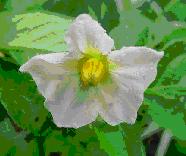 ....
....

 ....
....

EDZELL BLUE (pre 1915)
Possibly not 100 years old, because the origins are unknown, but it was first recorded in 1915, so it almost qualifies. This is a superb floury potato of outstanding flavour, believed to originate in Edzell, Scotland. I went there once but couldn't find any mention of the potato. Several seed companies have used our pictures of this variety on their websites. It's difficult to cook properly. If in doubt, steam rather than boil - it disintegrates.
Pictures:
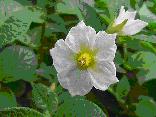 .....
.....

EPICURE (1897)
Floury first early raised in England by James Clark. Excellent flavour and well worth growing if you can find the seed.
Pictures (click on small images for detail):
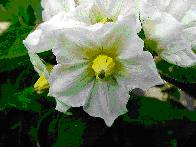 ....
....

GOLDEN WONDER (1902)
English. Russet sport of 'Langworthy', bred by James Clark. Probably the best flavoured potato. Very dry and floury. Enormous haulms. A must for every potato grower to try at least once.
Pictures (click on small images for detail):
 .......
.......
 .......
.......

JERSEY ROYAL (1879)
Too well-known to require much comment. Also known as International Kidney. Usually picked when immature and sold as 'Jersey Royal'. Waxy when young; floury when allowed to mature. Beautiful distinctive flavour; the first new potatoes of the English season. Bred by Robert Fenn, Berkshire.
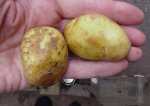
KING EDWARD (1902)
From Northumberland. Renowned for its flavour and cooking quality. Dry matter 6, holds together on boiling. There is a red variant, which is also shown below.
 .....
.....

MAJESTIC (1911)
Archibald Findlay variety, Scotland. The most popular UK potato for about thirty years.Lare, white, slightly rough-looking tubers; heavy yields. I've grown this a couple of times and kept the spuds until after Christmas; good texture and flavour, rather floury. Good all-round performer.
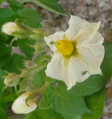 .....
.....

PINK FIR APPLE (c1850)
Maincrop. Unknown origin. Knobbly, nutty tubers, very waxy and firm; outstanding flavour. Dry matter 5. No resistance to blight at all - in a bad year you'll get no spuds at all. Nevertheless for a hobby grower you should try this one. Many grow it every year.
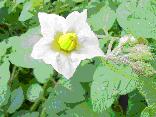 .....
.....

RATTE (1872)
Possibly Danish, possibly French. Early maincrop. Very similar to Pink Fir Apple but not so knobbly and the yield is higher. The flowers are purple rather than white. Superb flavour. I grew this before owning a digital camera, so no pictures. Must grow it again.
ROYAL KIDNEY (1899)
Scottish; another Archibald Findlay variety. A waxy, firm potato which boils well - the classic salad potato.

RUSSET BURBANK (1875)
I don't know where you can get this, apart from chips in MacDonald's. There seems to be no seed available for the amateur grower. It's American, and bred by Luther Burbank. Dry matter 6, no blight resistance at all, mealy, starchy, and great for dryish chips which don't break in the middle.
SHARPE'S EXPRESS (1900)
Introduced by Charles Sharpe of Sleaford, England. A very high dry matter first early, and as such, rather unusual. The cooking quality is first class, though when boiling them you have to stand over the saucepan with a knife to whisk them out of the water before they disintegrate.

UP-TO-DATE (1894)
Yet another winner from the giant of the potato world, Archibald Findlay. Scottish, obviously. Late maincrop, and was for years the main variety in the UK. The tubers are waxy, dry matter is 5, and the flavour / texture excellent, which is why it's still around after a century. Beautiful purple flowers.
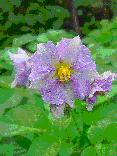 .....
.....

.................OK - there, for your interest, are the 'centenarians'. Astonishingly, four of them bred by the same man.
It would be interesting to be around after another century to see which spuds have lasted - or to see if any of these are capable of lasting two centuries. I suspect one or two of Jack Dunnett's might make the list, and I'd be surprised if there weren't a few with coloured flesh making an appearance.
ND / Diversity website